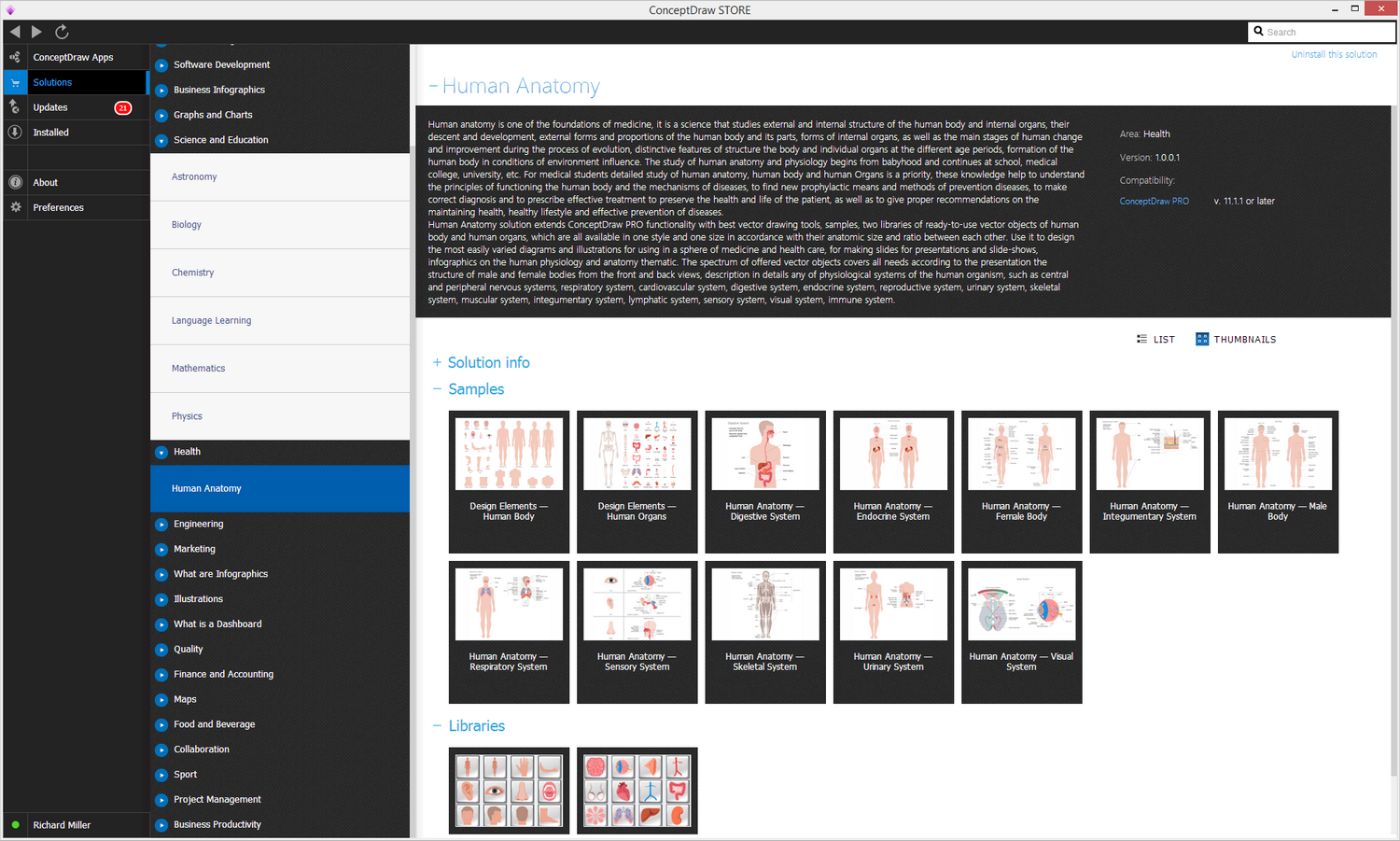- Electric and Telecom Plans Free
- Fire and Emergency Plans Free
- Floor Plans Free
- Plant Layout Plans Free
- School and Training Plans Free
- Seating Plans Free
- Security and Access Plans Free
- Site Plans Free
- Sport Field Plans Free
- Business Process Diagrams Free
- Business Process Mapping Free
- Classic Business Process Modeling Free
- Cross-Functional Flowcharts Free
- Event-driven Process Chain Diagrams Free
- IDEF Business Process Diagrams Free
- Logistics Flow Charts Free
- Workflow Diagrams Free
- ConceptDraw Dashboard for Facebook Free
- Mind Map Exchange Free
- MindTweet Free
- Note Exchange Free
- Project Exchange Free
- Social Media Response Free
- Active Directory Diagrams Free
- AWS Architecture Diagrams Free
- Azure Architecture Free
- Cisco Network Diagrams Free
- Cisco Networking Free
- Cloud Computing Diagrams Free
- Computer Network Diagrams Free
- Google Cloud Platform Free
- Interactive Voice Response Diagrams Free
- Network Layout Floor Plans Free
- Network Security Diagrams Free
- Rack Diagrams Free
- Telecommunication Network Diagrams Free
- Vehicular Networking Free
- Wireless Networks Free
- Comparison Dashboard Free
- Composition Dashboard Free
- Correlation Dashboard Free
- Frequency Distribution Dashboard Free
- Meter Dashboard Free
- Spatial Dashboard Free
- Status Dashboard Free
- Time Series Dashboard Free
- Basic Circle-Spoke Diagrams Free
- Basic Circular Arrows Diagrams Free
- Basic Venn Diagrams Free
- Block Diagrams Free
- Concept Maps Free
- Family Tree Free
- Flowcharts Free
- Basic Area Charts Free
- Basic Bar Graphs Free
- Basic Divided Bar Diagrams Free
- Basic Histograms Free
- Basic Line Graphs Free
- Basic Picture Graphs Free
- Basic Pie Charts Free
- Basic Scatter Diagrams Free
- Aerospace and Transport Free
- Artwork Free
- Audio, Video, Media Free
- Business and Finance Free
- Computers and Communications Free
- Holiday Free
- Manufacturing and Maintenance Free
- Nature Free
- People Free
- Presentation Clipart Free
- Safety and Security Free
- Analog Electronics Free
- Audio and Video Connectors Free
- Basic Circuit Diagrams Free
- Chemical and Process Engineering Free
- Digital Electronics Free
- Electrical Engineering Free
- Electron Tube Circuits Free
- Electronic Block Diagrams Free
- Fault Tree Analysis Diagrams Free
- GHS Hazard Pictograms Free
- Home Automation and Wiring Free
- Mechanical Engineering Free
- One-line Diagrams Free
- Power Сircuits Free
- Specification and Description Language (SDL) Free
- Telecom and AV Circuits Free
- Transport Hazard Pictograms Free
- Data-driven Infographics Free
- Pictorial Infographics Free
- Spatial Infographics Free
- Typography Infographics Free
- Calendars Free
- Decision Making Free
- Enterprise Architecture Diagrams Free
- Fishbone Diagrams Free
- Organizational Charts Free
- Plan-Do-Check-Act (PDCA) Free
- Seven Management and Planning Tools Free
- SWOT and TOWS Matrix Diagrams Free
- Timeline Diagrams Free
- Australia Map Free
- Continent Maps Free
- Directional Maps Free
- Germany Map Free
- Metro Map Free
- UK Map Free
- USA Maps Free
- Customer Journey Mapping Free
- Marketing Diagrams Free
- Matrices Free
- Pyramid Diagrams Free
- Sales Dashboard Free
- Sales Flowcharts Free
- Target and Circular Diagrams Free
- Cash Flow Reports Free
- Current Activities Reports Free
- Custom Excel Report Free
- Knowledge Reports Free
- MINDMAP Reports Free
- Overview Reports Free
- PM Agile Free
- PM Dashboards Free
- PM Docs Free
- PM Easy Free
- PM Meetings Free
- PM Planning Free
- PM Presentations Free
- PM Response Free
- Resource Usage Reports Free
- Visual Reports Free
- House of Quality Free
- Quality Mind Map Free
- Total Quality Management TQM Diagrams Free
- Value Stream Mapping Free
- Astronomy Free
- Biology Free
- Chemistry Free
- Language Learning Free
- Mathematics Free
- Physics Free
- Piano Sheet Music Free
- Android User Interface Free
- Class Hierarchy Tree Free
- Data Flow Diagrams (DFD) Free
- DOM Tree Free
- Entity-Relationship Diagram (ERD) Free
- EXPRESS-G data Modeling Diagram Free
- IDEF0 Diagrams Free
- iPhone User Interface Free
- Jackson Structured Programming (JSP) Diagrams Free
- macOS User Interface Free
- Object-Role Modeling (ORM) Diagrams Free
- Rapid UML Free
- SYSML Free
- Website Wireframe Free
- Windows 10 User Interface Free
Human Anatomy
Human anatomy is one of the foundations of medicine, it is a science that studies external and internal structure of the human body and internal organs, their descent and development, external forms and proportions of the human body and its parts, forms of internal organs, as well as the main stages of human change and improvement during the process of evolution, distinctive features of structure the body and individual organs at the different age periods, formation of the human body in conditions of environment influence. The study of human anatomy and physiology starts from babyhood and continues at school, medical college, university, etc. For medical students detailed study of human anatomy, human body and human Organs is a priority, these knowledge help to understand the principles of functioning the human body and the mechanisms of diseases, to find new prophylactic means and methods of prevention diseases, to make correct diagnosis and to prescribe effective treatment to preserve the health and life of the patient, as well as to give proper recommendations on the maintaining health, healthy lifestyle and effective prevention of diseases.
Human Anatomy solution extends ConceptDraw DIAGRAM functionality with best vector drawing tools, samples, two libraries of ready-to-use vector objects of human body and human organs, which are all available in one style and one size in accordance with their anatomic size and ratio between each other. Use it to design the most easily varied diagrams and illustrations for using in a sphere of medicine and health care, for making slides for presentations and slide-shows, infographics on the human physiology and anatomy thematic. The range of offered vector objects covers all needs in accordance with the presentation of the structure of male and female bodies on both sides, a detailed description of any of the physiological systems of the human body, such as the central and peripheral nervous systems, respiratory system, cardiovascular system, digestive system, endocrine system, reproductive system, urinary system, skeletal system, muscular system, integumentary system, lymphatic system, sensory system, visual system, immune system.
-
Buy this solution $25 -
Solution Requirements - This solution requires the following products to be installed:
ConceptDraw DIAGRAM v18 - This solution requires the following products to be installed:
-
Compatibility - Sonoma (14), Sonoma (15)
MS Windows 10, 11 - Sonoma (14), Sonoma (15)
-
Support for this Solution -
Helpdesk
The Human Anatomy solution contains 10 examples and 2 libraries containing 98 vector graphics and icons, to allow you to create professional looking documents.
Design Elements — Human Body
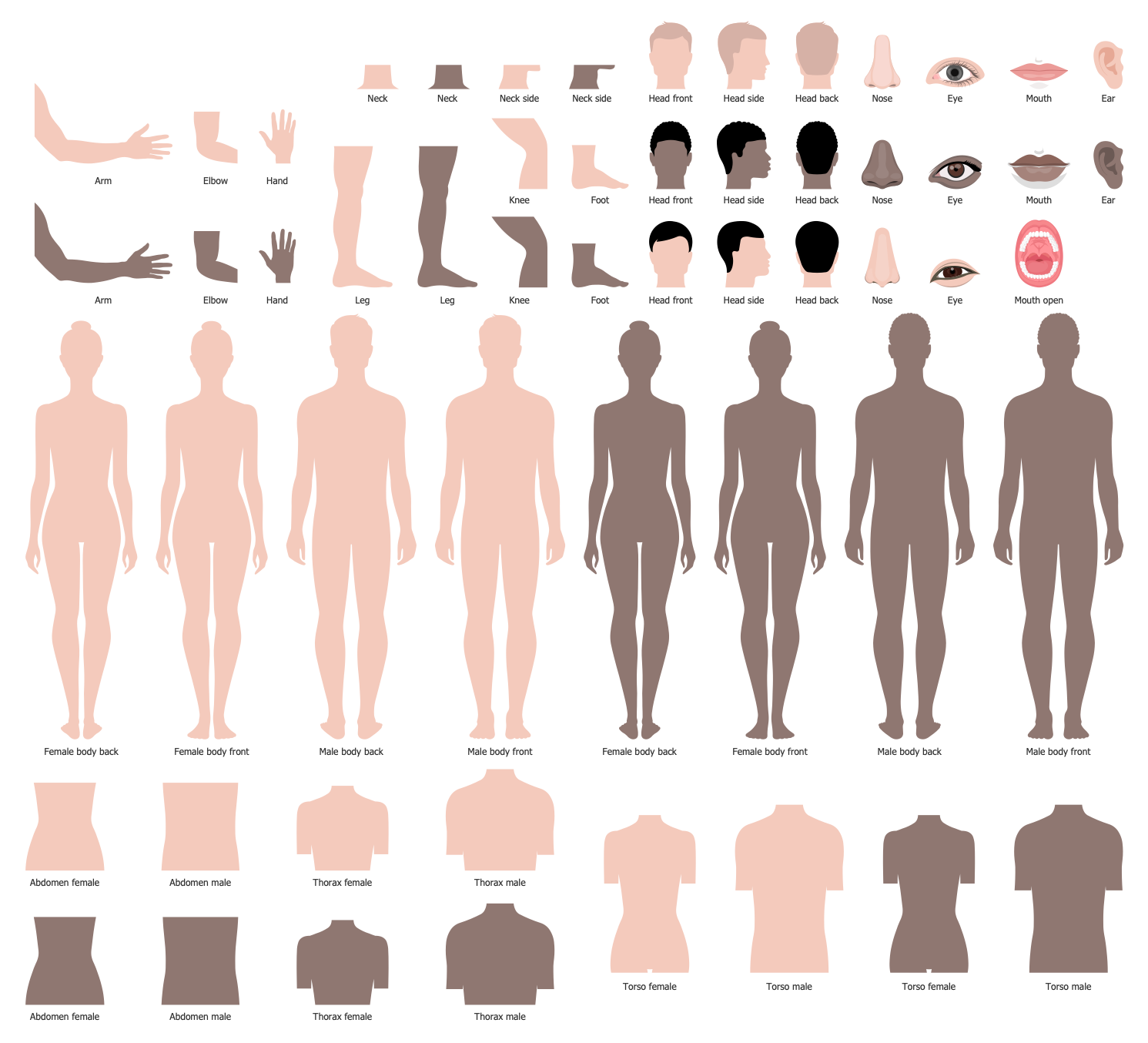
Design Elements — Human Organs
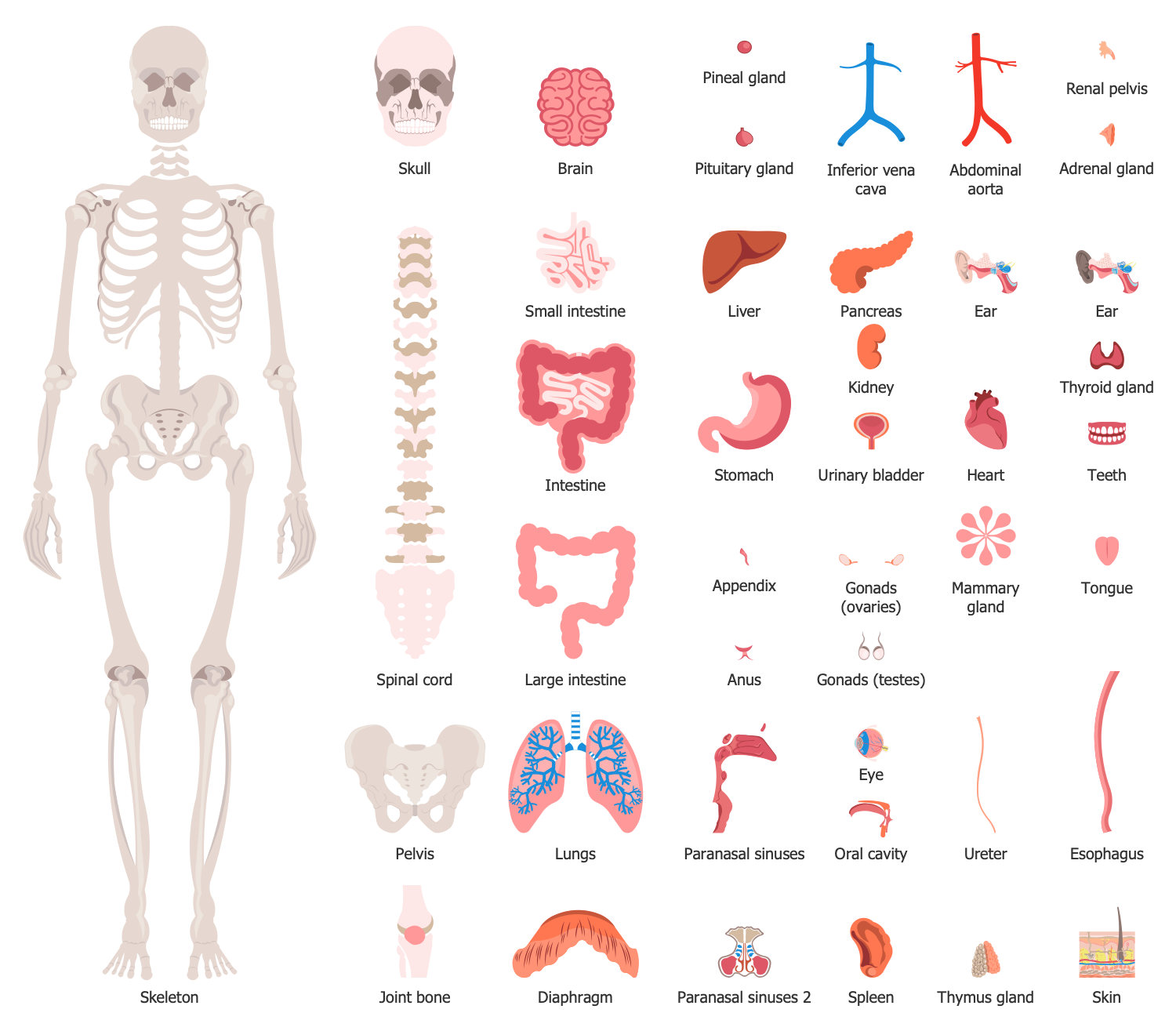
Related News:
Examples
There are a few samples that you see on this page which were created in the ConceptDraw DIAGRAM application by using the Human Anatomy solution. Some of the solution's capabilities as well as the professional results which you can achieve are all demonstrated here on this page.
All source documents are vector graphic documents which are always available for modifying, reviewing and/or converting to many different formats, such as MS PowerPoint, PDF file, MS Visio, and many other graphic ones from the ConceptDraw Solution Park or ConceptDraw STORE. The Human Anatomy solution is available to all ConceptDraw DIAGRAM users to get installed and used while working in the ConceptDraw DIAGRAM diagramming and drawing software.
Example 1: Human Anatomy — Digestive System
This diagram was created in ConceptDraw DIAGRAM using the combination of libraries from the Human Anatomy Solution. An experienced user spent 10 minutes creating this sample.
This Human anatomy diagram depicts the structure of the digestive system of an adult. The digestive system is a totality of the digestive organs that performs the transformation of food to the nutrients available for the body's absorption, provides the body with required energy, without which the intensive recovery of tissues and cells is not possible. The main function of the digestive system is the digestion. It consists of the gastrointestinal tract that includes the mouth, pharynx, esophagus, stomach, gallbladder, liver, pancreas, small intestine, large intestine, appendix, anus, and also the set of accessory organs of digestion, among which the tongue and salivary glands. The digestive process passes in several stages and begins at the mouth with a mastication of food into the small pieces. You can use this sample as is or also add on it the accessory digestive organs to make the extensive illustration of digestive system in ConceptDraw DIAGRAM software.
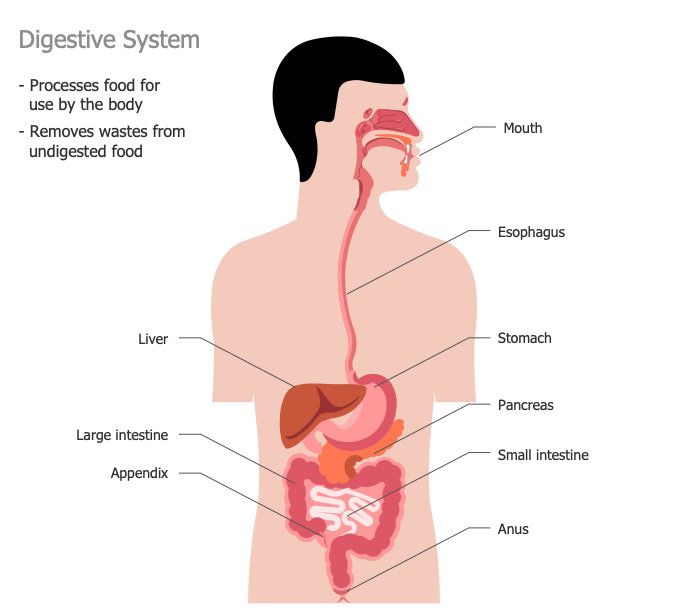
Example 2: Human Anatomy — Endocrine System
This diagram was created in ConceptDraw DIAGRAM using the combination of libraries from the Human Anatomy Solution. An experienced user spent 10 minutes creating this sample.
This Human anatomy scheme designed with help of ready-to-use ConceptDraw objects from the libraries of Human Anatomy solution, represents in details the structure of endocrine system of women and man. The endocrine system is a collection of ductless glands that produce hormones and biologically active substances. It is multifunctional system that takes part in chemical processes, is one of generators of human's energy, it coordinates the activities of all organs and other structures, provides humoral regulation of body functions, assists in maintenance of a constant and stable flowing of life processes in conditions of permanent changing external conditions, and in conjunction with nervous system it regulates the growth and development of an organism, functioning of reproductive system and sexual differentiation. The main types of endocrine glands are represented on this sample; these are the pineal gland, pituitary gland, hypothalamus, thyroid gland, parathyroid gland, thymus gland, adrenal glands, pancreas, and gonads (ovaries and testes).
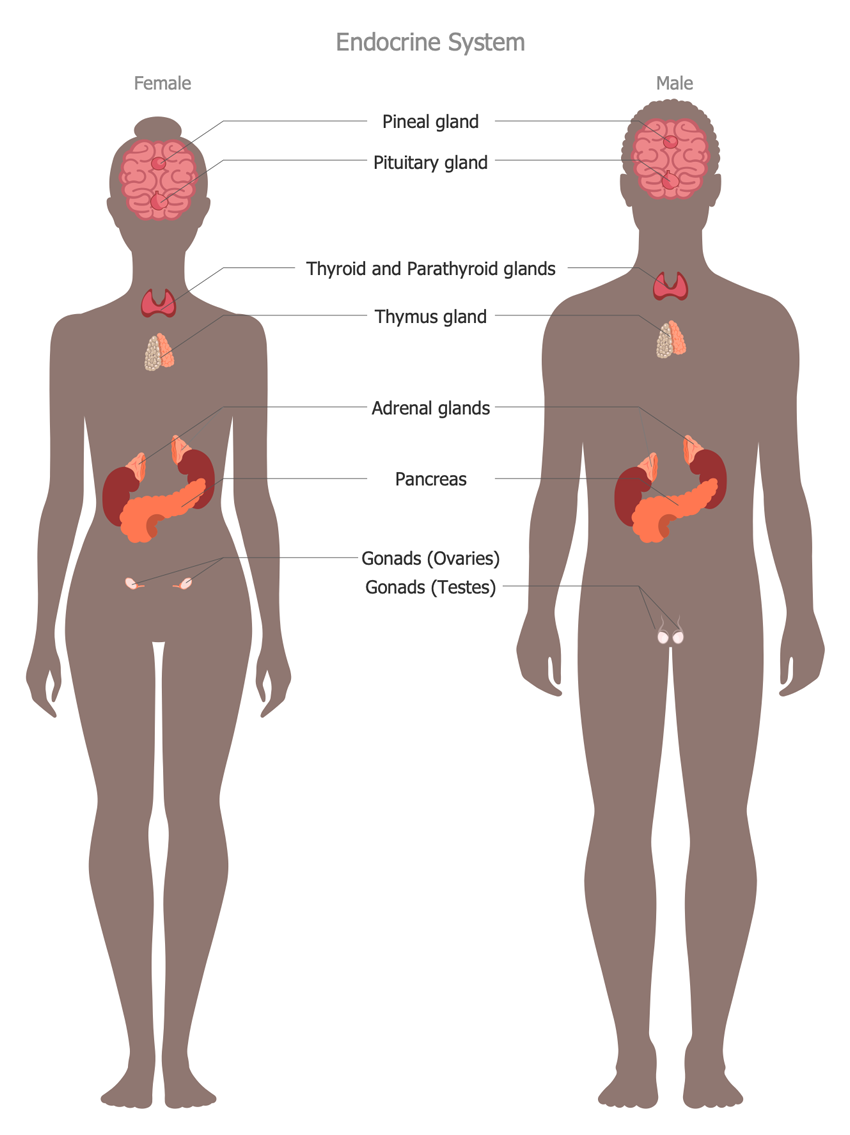
Example 3: Human Anatomy — Female Body
This diagram was created in ConceptDraw DIAGRAM using the combination of libraries from the Human Anatomy Solution. An experienced user spent 15 minutes creating this sample.
This human anatomy illustration describes the parts of the female body in a visual form with help of ConceptDraw software tools. The anatomy of female body differentiates from the male body by primary specifics and secondary sexual characteristics. The first thing that catches the eyes is the external difference of women's body, starting with obvious specifics of figure: the waist that is narrower than bust and hips, all these three points are called inflection points. On the development of secondary sexual characteristics influence the hormones estrogens. The names of all parts of female body defined on this illustration will help you to study better the characteristics of the female body, moreover it is perfect and visual for representation to children and adults during the lessons of anatomy at school or university, can be used on the illustrative posters at the policlinics and medical centers. Placing nearby a similar scheme of the male body, you can visualize their differences.
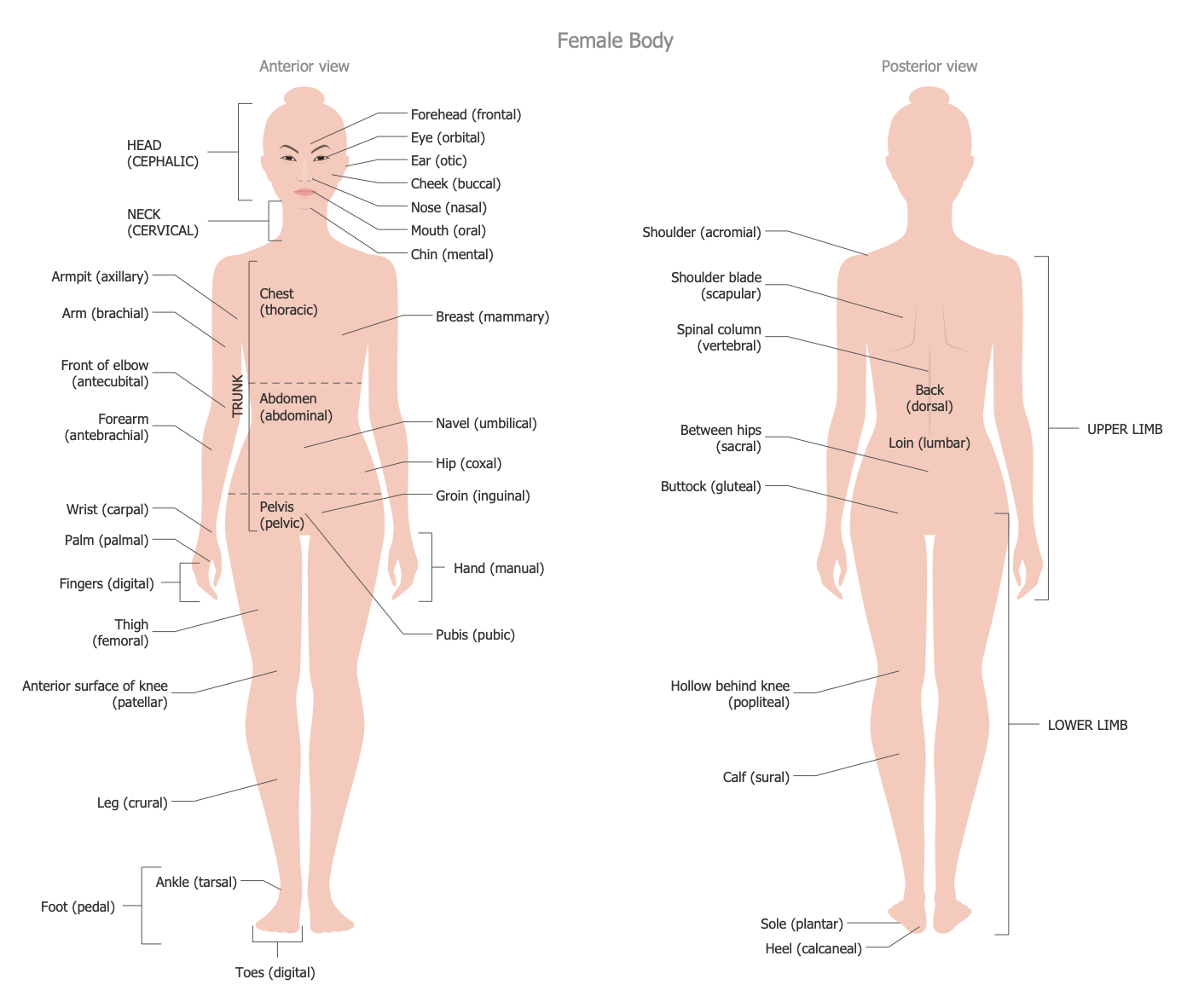
Example 4: Human Anatomy — Integumentary System
This diagram was created in ConceptDraw DIAGRAM using the combination of libraries from the Human Anatomy Solution. An experienced user spent 10 minutes creating this sample.
This Human anatomy illustration sample depicts the integumentary system in a visual form. The integumentary system is the system of organs covering the outside of the human body and performing the protective, receptive and homeostatic functions. This system includes the skin, hair and nails. The information about this, as well as detailed description of the skin's structure is represented on this sample with help of predesigned vector objects and clipart from the libraries of the Human Anatomy solution. There are counted three layers at the structure of human skin: the external is epidermis, the middle is dermis (the actual skin) and internal is hypodermis (subcutaneous fat). These are the basic components of the skin, but the diagram also offers the expanded description of the skin's structure. Combine the different aspects of knowledge on a given subject within a single illustration for better informativeness and readability of information with a single look.

Example 5: Human Anatomy — Male Body
This diagram was created in ConceptDraw DIAGRAM using the combination of libraries from the Human Anatomy Solution. An experienced user spent 15 minutes creating this sample.
This Human anatomy sample is an illustration of the male body and description of its parts. The male body significantly differs from the female body, both internally and externally, amongst the differences are the primary signs, external signs, among which are more prominent brow bone, heavier jaw, more prominent chin, larger nose bone, and many others, the differences in brain structure, hormonal background, the vocal apparatus, visual system, gustatory and auditory analyzers, behavior, desires, abilities, thoughts, etc. This sample represents the interior and exterior views of the male body, contains the names of each part of the body. At your desire, you can add detailed descriptions of organs, to demonstrate any system of organs taking this sample as the base for any other detailed Human anatomy illustration, for making the images representing features of work of various systems at the male body, for depiction the main differences of men from women (physical, psychological and others).
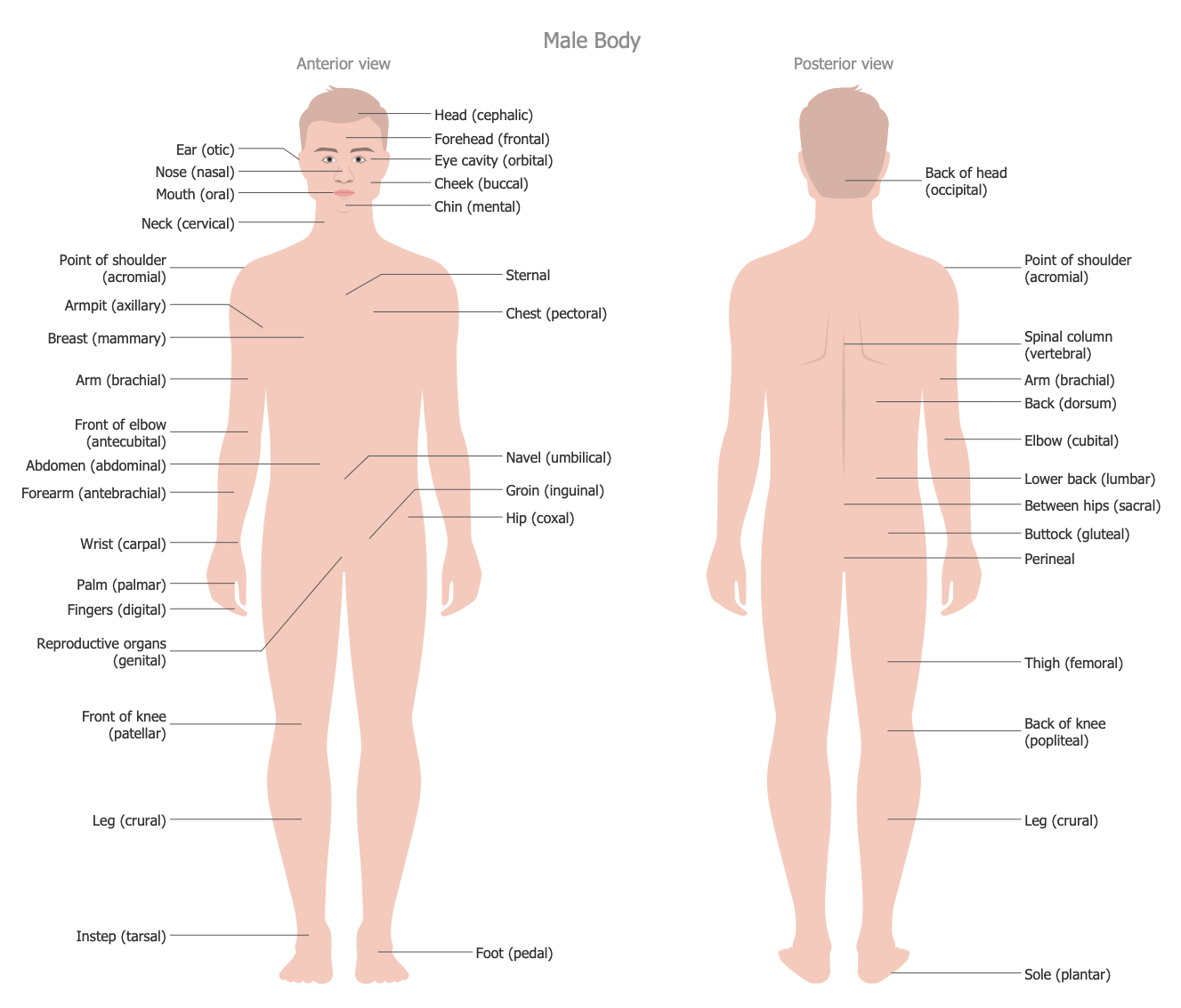
Example 6: Human Anatomy — Respiratory System
This diagram was created in ConceptDraw DIAGRAM using the combination of libraries from the Human Anatomy Solution. An experienced user spent 15 minutes creating this sample.
This human anatomy illustration depicts the respiratory system of each human. The respiratory system, also called the respiratory apparatus or ventilatory system, is one of the most important systems at human's organism. It consists from specific organs and structures, which realize the gas exchange between the air and blood by diffusion of oxygen and carbon dioxide through the pulmonary alveoli into the blood capillaries. The respiratory system includes the upper and lower airways, and lungs consisting from the bronchioles and alveolar sacs, and also arteries, capillaries and veins of the pulmonary circulation. The upper respiratory tract contains the nose, nasal cavities, sinuses, pharynx, and the part of larynx above the vocal folds. The larynx, trachea, bronchi, bronchioles, and alveoli are included to the lower respiratory tract. The respiratory system contains also the thoracic cage, respiratory muscles, respiratory center located at the brain, peripheral nerves and receptors involved at the regulation of breathing.
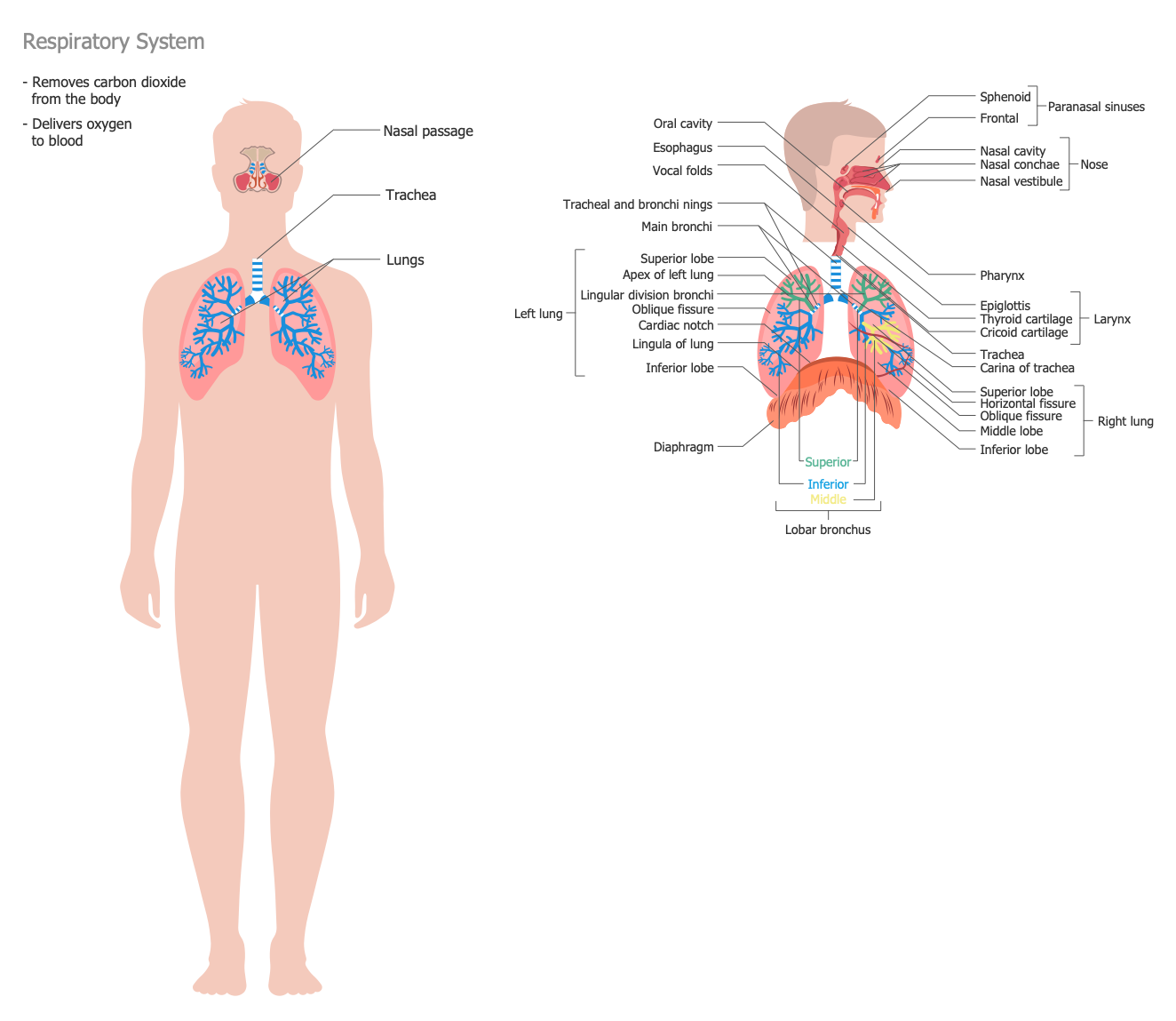
Example 7: Human Anatomy — Sensory System
This diagram was created in ConceptDraw DIAGRAM using the combination of libraries from the Human Anatomy Solution. An experienced user spent 20 minutes creating this sample.
This sample Human anatomy is devoted to detailed description with illustrations of five senses organs composing the human's sensory system and intended to interact with the outside world: the organ of sight – eyes, hearing – ears, smell – nose, touch – skin, and taste – tongue. Thanks to the eyes the human sees, the ears allow to hear sounds and vibrations, through the tongue we experience the taste and temperature of food, the nose helps to feel the smell and scents, and the skin provides us with tactile sensations, touch, pain and sensation of temperature of surrounding world. Sometimes a sixth sense organ is added to this list — the vestibular system, thanks to which we are aware of our place in space, maintain balance, feel weight and position. The sensory organs perceive the information, which then is transformed into a nerve impulse and gets into the brain for analyzing and forming response reaction. For each organ of sense corresponds a certain area of cerebral cortex, which processes the signals from outside.

Example 8: Human Anatomy — Skeletal System
This diagram was created in ConceptDraw DIAGRAM using the combination of libraries from the Human Anatomy Solution. An experienced user spent 10 minutes creating this sample.
This Anatomy sample illustrates the human’s skeletal system. The skeleton is an internal framework of the human's body, it performs six major functions; support, movement, protection, storage of minerals, production of blood cells, and also endocrine regulation. The human's skeleton is composed from more than 200 bones joined at one whole with help of joints, cartilages and ligaments. The bones of the skull contain the cranium and facial parts, the trunk consists from the spinal column (spine) and the chest (ribs and the breastbone). The spinal column includes the cervical vertebrae, thoracic vertebrae, lumbar vertebrae, sacrum and coccyx. The upper extremity consists from the bones of arm, forearm and hand; the lower extremity is formed from the thigh, leg and foot. At the composition of the bones are included organic and inorganic substances, the presence of organic substances defines the bones' elasticity, the hardness is provided by the mineral salts.
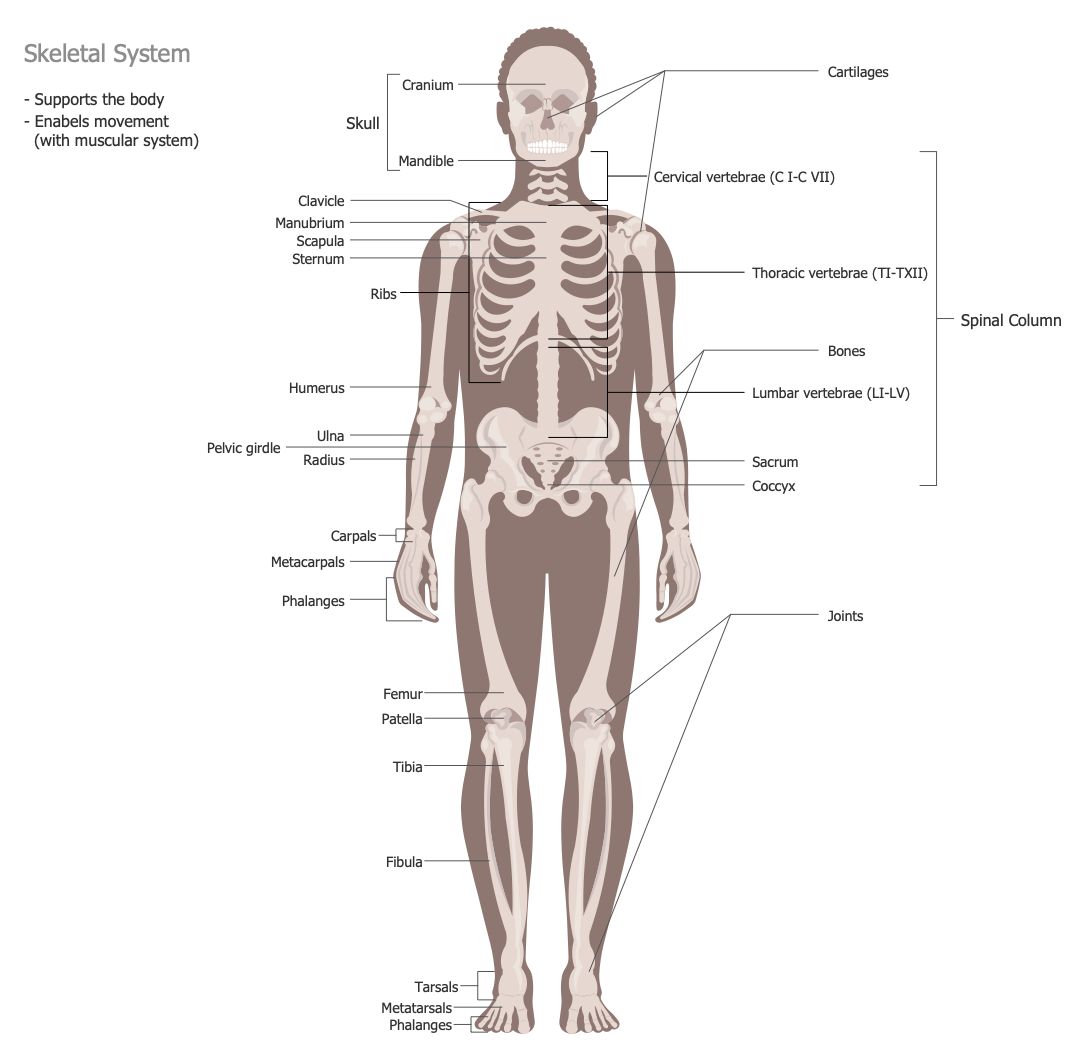
Example 9: Human Anatomy — Urinary System
This diagram was created in ConceptDraw DIAGRAM using the combination of libraries from the Human Anatomy Solution. An experienced user spent 15 minutes creating this sample.
This Human anatomy example demonstrates the human’s urinary system or the renal system, the main components of which are the kidneys, ureters, bladder, and urethra. The urinary system performs the function of detoxification, excretion of unnecessary and harmful compounds, regulation of blood volume and blood pressure, as well as regulation the blood pH, controlling levels of electrolytes and metabolites, while maintaining at the body the necessary amounts of mineral salts and water. The leading role at the secretory processes of the human body belongs to the kidneys, which are the organ where is realized the formation of urine, other urinary organs are intended for removing urine. The kidneys consist of millions of functional units called nephrons, they filtrate the large volume of blood and remove the wastes in a form of urine via the ureters to the urinary bladder, where it is stored and from where is removed from the body. The single difference between male and female urinary system is the urethra's length.
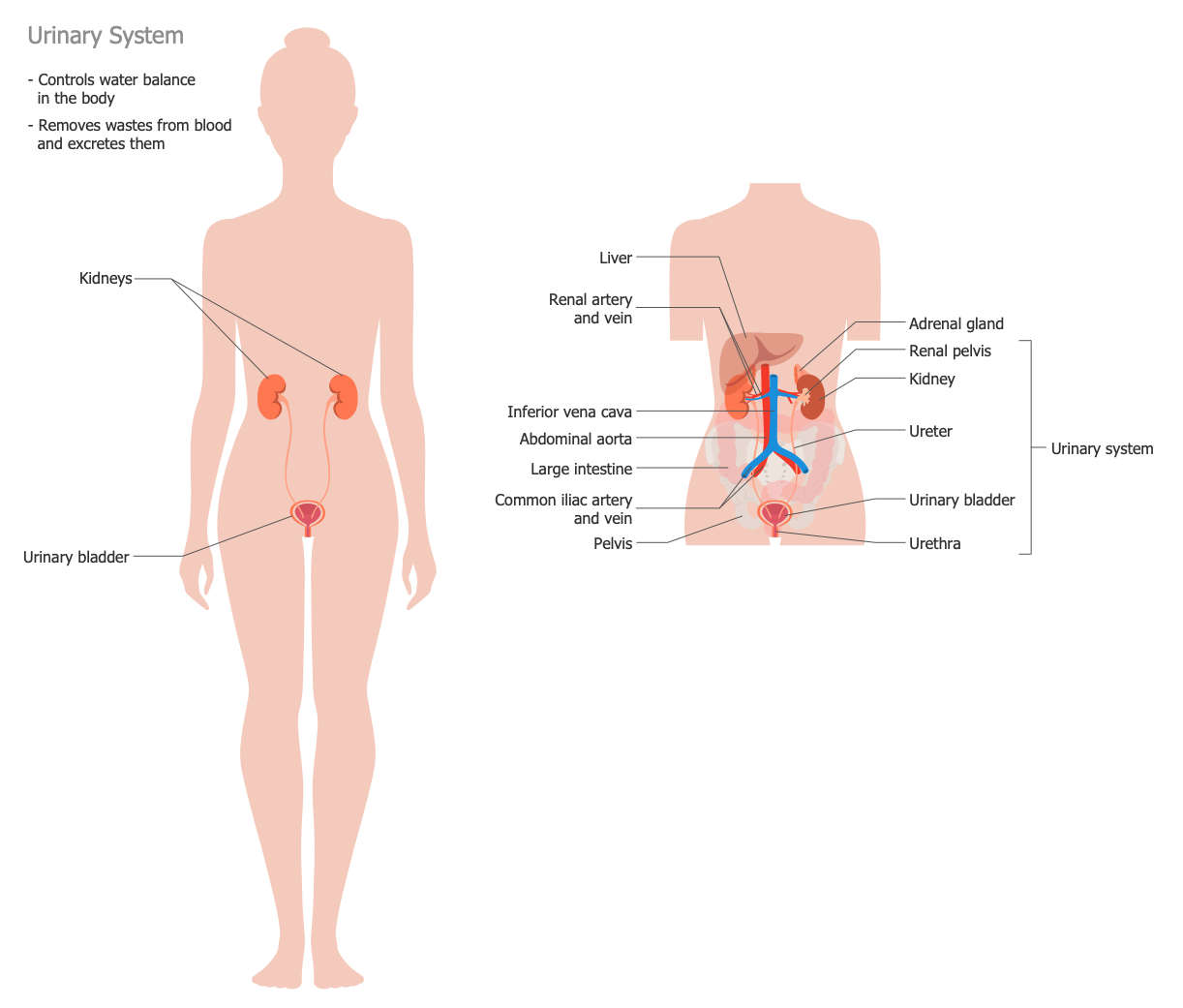
Example 10: Human Anatomy — Visual System
This diagram was created in ConceptDraw DIAGRAM using the combination of libraries from the Human Anatomy Solution. An experienced user spent 15 minutes creating this sample.
This Human anatomy sample is devoted to detailed description of unique human's body system - a visual system, which is a part of the central nervous system. The vision has incredibly important value at human's life, it is one of the basic sensory channels, which connects a human with surrounding world, lets obtain the most detailed and specific information. It is a way of perception the information about surrounding world with help of light, moreother this perfect ability assists us to perceive our world in bright colors and volume, to differentiate images, movements, contrast, color gammas and other details. The extensive value of a visual system largely explains the complexity of its structure. The human eye has a spherical shape, the main parts of eye’s structure are the optic nerve, optic disk, retina, retinal blood vessels, sclera, macula, fovea, uvea forming from iris, ciliary body and choroid, suspensory ligament of lens, posterior chamber, anterior chamber, pupil and cornea.
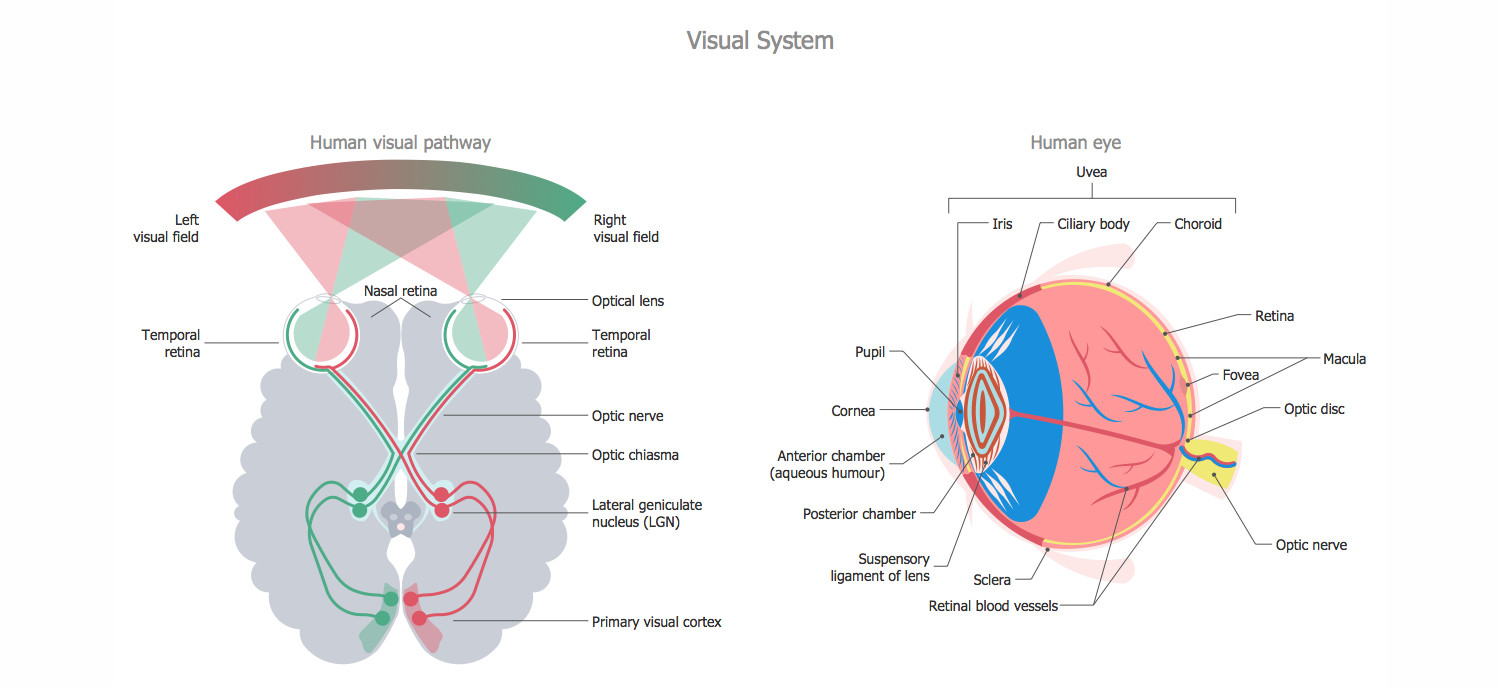
Inside

What I Need to Get Started
After ConceptDraw DIAGRAM is installed, the Human Anatomy solution can be purchased either from the Health area of ConceptDraw STORE itself or from our online store. Thus, you will be able to use the Human Anatomy solution straight after.
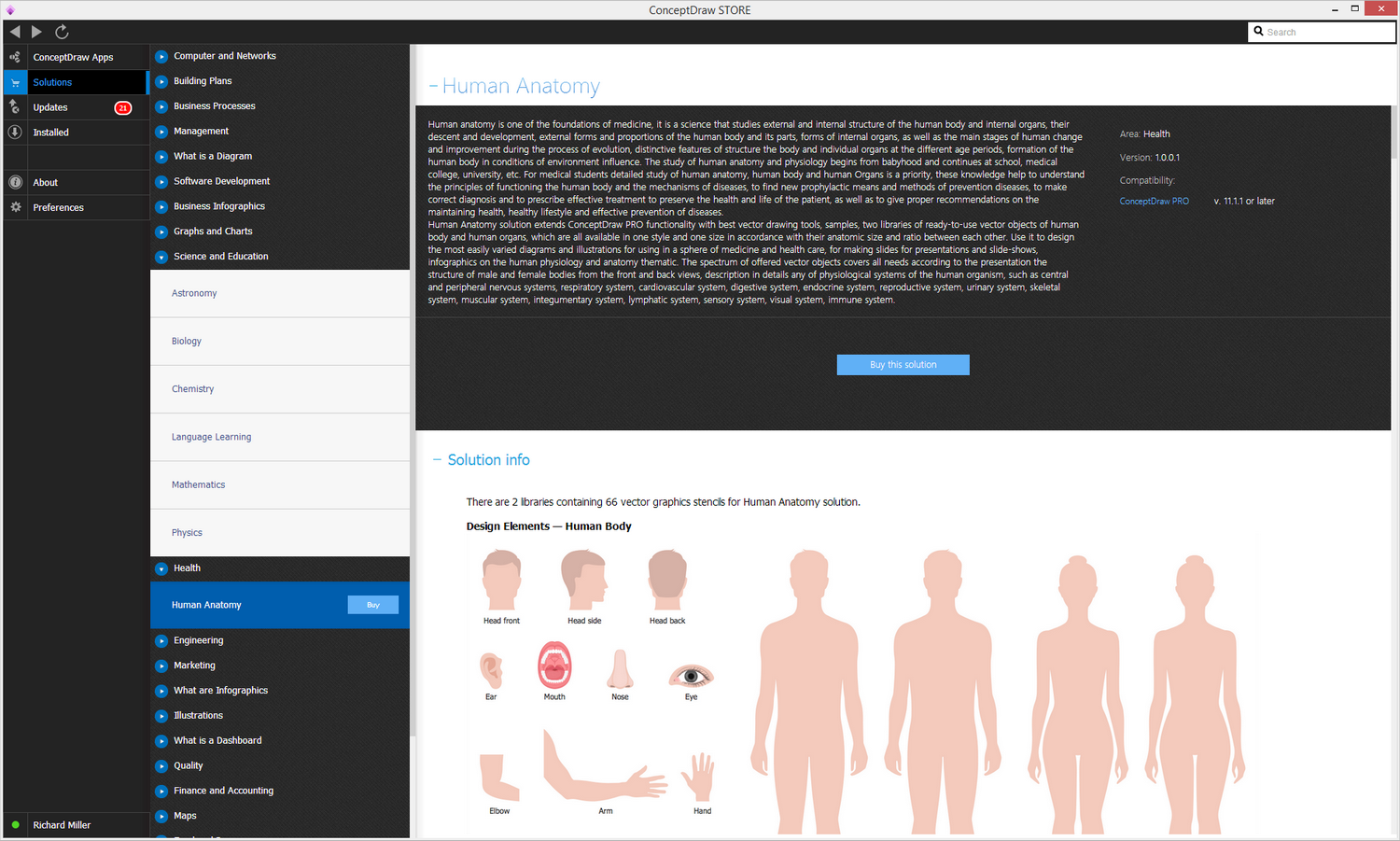
How to install
First of all, make sure that both ConceptDraw STORE and ConceptDraw DIAGRAM applications are downloaded and installed on your computer. Next, install the Human Anatomy solution from the ConceptDraw STORE to use it in the ConceptDraw DIAGRAM application.
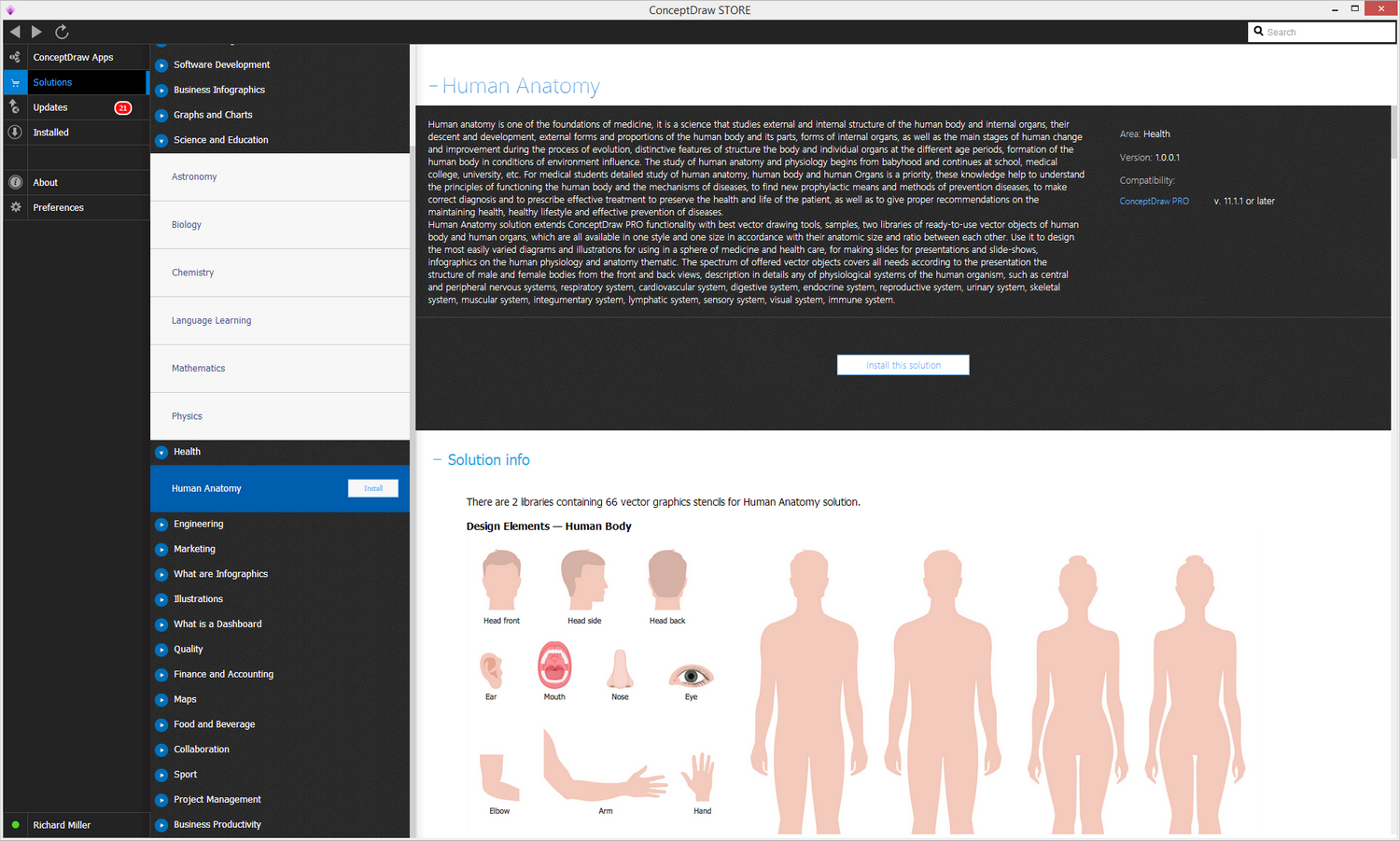
Start using
Start using the Human Anatomy solution to make the professionally looking illustrations by adding the design elements taken from the stencil libraries and editing the pre-made examples that can be found there.
